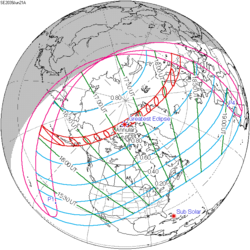| Annular eclipse | |
| Gamma | 0.0398 |
|---|---|
| Magnitude | 0.9911 |
| Maximum eclipse | |
| Duration | 60 s (1 min 0 s) |
| Coordinates | 25°24′N21°54′W / 25.4°N 21.9°W |
| Max. width of band | 31 km (19 mi) |
| Times (UTC) | |
| Greatest eclipse | 13:32:55 |
| References | |
| Saros | 137 (37 of 70) |
| Catalog # (SE5000) | 9593 |
An annular solar eclipse will occur at the Moon's ascending node of orbit on Friday, July 2, 2038, [1] with a magnitude of 0.9911. A solar eclipse occurs when the Moon passes between Earth and the Sun, thereby totally or partly obscuring the image of the Sun for a viewer on Earth. An annular solar eclipse occurs when the Moon's apparent diameter is smaller than the Sun's, blocking most of the Sun's light and causing the Sun to look like an annulus (ring). An annular eclipse appears as a partial eclipse over a region of the Earth thousands of kilometres wide. Occurring about 6 days after apogee (on June 26, 2038, at 13:55 UTC), the Moon's apparent diameter will be smaller. [2]
Contents
- Images
- Eclipse timing
- Places experiencing annular eclipse
- Places experiencing partial eclipse
- Eclipse details
- Eclipse season
- Related eclipses
- Eclipses in 2038
- Metonic
- Tzolkinex
- Half-Saros
- Tritos
- Solar Saros 137
- Inex
- Triad
- Solar eclipses of 2036–2039
- Saros 137
- Metonic series
- Tritos series
- Inex series
- References
- External links
This solar eclipse is notable as it is the closest eclipse in Saros 137 to the subsolar point with an eclipse gamma of 0.0398.
Annularity will be visible from parts of Colombia, Venezuela, Grenada, Barbados, Western Sahara, Mauritania, northern Mali, southern Algeria, Niger, Chad, southwestern Sudan, South Sudan, southern Ethiopia, northeastern Kenya, and southwestern Somalia. A partial eclipse will be visible for parts of eastern North America, Central America, the Caribbean, northern South America, Africa, Western Europe, and the Middle East.








































































































